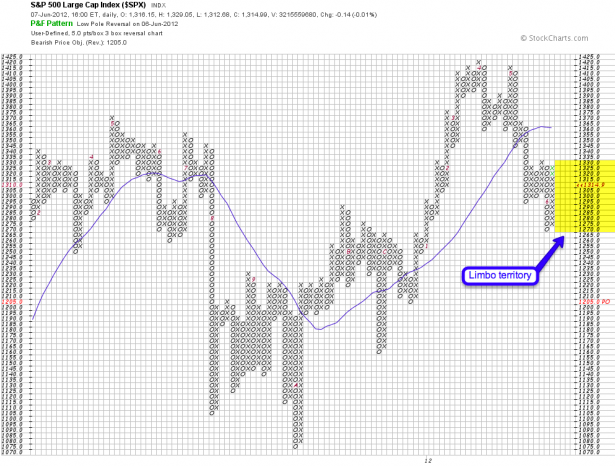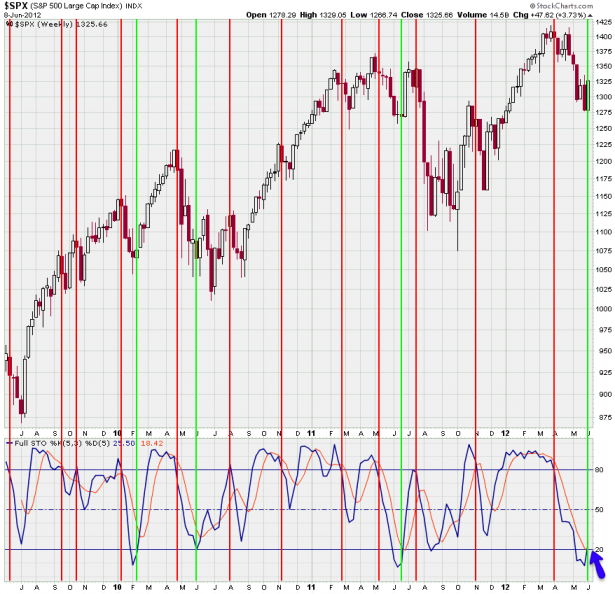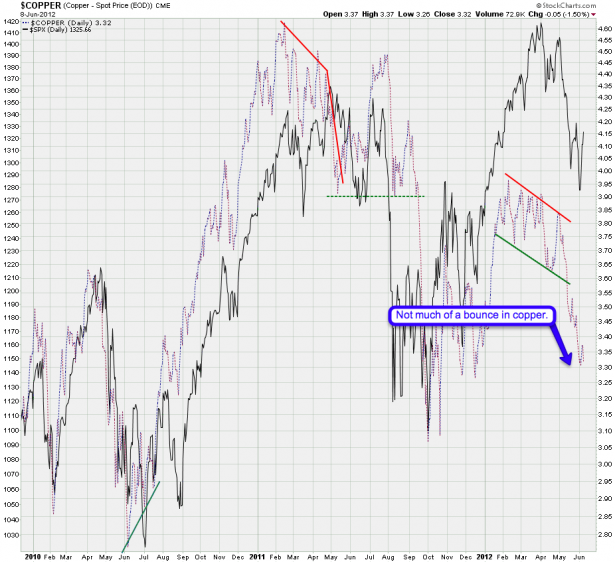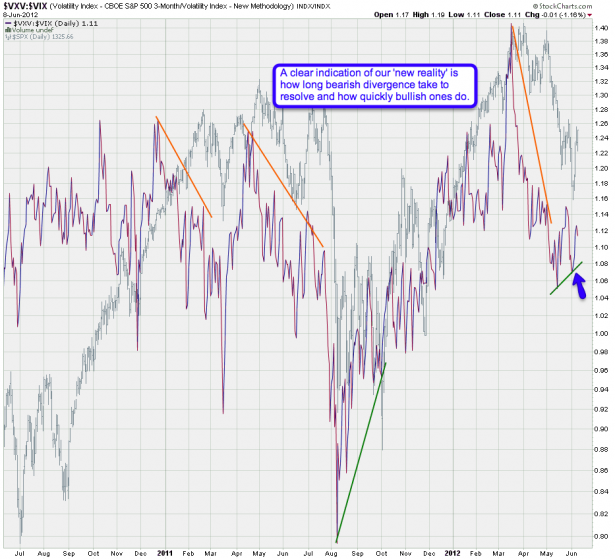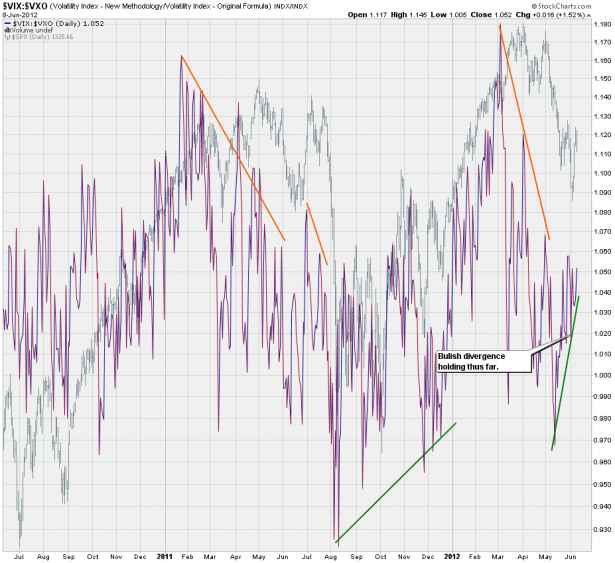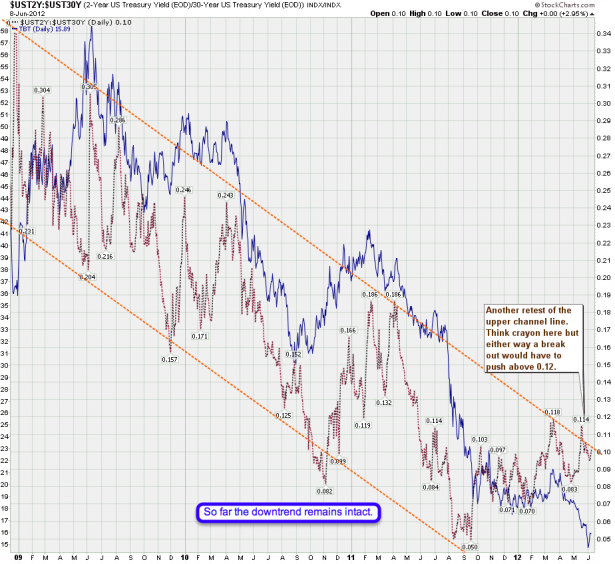Market Weather
Market Weather
Trading is like a butterfly. Chase it and it eludes you. Instead, sit down quietly and watch it come to you.
Yesterday afternoon I suddenly had an epiphany of sorts. I was thinking about the recent tape and how it has been rather easy to get whipsawed to pieces in the recent gapping game. And somewhere out of the blue it suddenly struck me that there is a key aspect to trading I actually have never seen addressed anywhere. Maybe I haven’t read some the pertinent books out there – always a possibility. As I have been around the block a few times I had the chance to devour quite a bit of reading material covering a whole gamut of trading related subjects.

One of my favorite topics always was and remains to be trading psychology. Learning about the inherent pitfalls of our cognitive biases for instance was a key turning point in my life as a trader. Even wave theory (which I don’t follow any longer) in some ways taught me to look at cycles and subconsciously I do still think in those general terms when it comes to assessing the overall direction of the tape.
What I however have not seen addressed clearly is market weather. Most of you reading this know about market psychology – Investopedia defines it as:
The overall sentiment or feeling that the market is experiencing at any particular time. Greed, fear, expectations and circumstances are all factors that contribute to the group’s overall investing mentality or sentiment.
Well, this sheds at least some light as to why investors and traders occasionally make very bad decisions that in hindsight just don’t add up. Why is a VIX of 25 considered high during some market periods and low at others? Why is the Dow at or above 10,000 meaningful when it comes to assessing the ongoing trend? Why is GOOG at 500 considered hopelessly overpriced on the way up but a steal on the way down? Obviously it’s all about investor sentiment and much material has been devoted to reprogramming our feeble minds so that we don’t constantly trip over our own emotions, assumptions, and (mis)interpretations of reality.
Market weather as a concept however seems to have not been covered or at least only been circled around. Going back to wave theory – it does teach us that certain waves have characteristics in form as well as velocity. For instance second waves are considered corrective and often convoluted while third waves are known to be fast and usually more or less unidirectional. But where wave theory breaks down in my opinion is that it constantly attempts to make predictions about what comes next. In some ways it trips over its own arrogance in that it attempts to predict the future by analyzing the past and projecting a continuation of a pattern on several fractal degrees. With counting rules that can be interpreted in many ways. Suffice to say it gets complicated quickly and in the end I don’t see much edge.
Market Weather
One core assumption inherent in wave theory however is correct – the tape does move in repeating patterns or periods. But it’s actually a lot less complicated than you may think. As a matter of fact there are only three major patterns I can think of and all of them feed off market sentiment or common human weaknesses.
I call it market weather. Instead of sunny, rainy, overcast, stormy, foggy, etc. we only have three: Limbo, Rocket, and Honeypot. It’s not sufficient to only be cognizant of the ongoing trend in whatever market you find yourself trading. In order to get positioned most effectively you must always consider the current market weather and if current conditions support a successful trade. Some systems actually do this implicitly but becoming aware of market weather may actually lead you into recognizing more effective setups.
- Limbo: The tape keeps you guessing.
Feeds of: Confusion, opinions (cerebral). - Rocket: The tape runs away from you.
Feeds of: Pain. - Honeypot: The tape lures you in and shakes out the weak.
Feeds of: Greed, fear (emotional).
Lather – rinse – repeat. It really is that simple if you think about it. Look, Ms. Market is a very cruel mistress and as such is always out to hurt the maximum number of participants. Hence money flows from weak hands to strong hands. From the majority to the minority. It’s a zero sum game – for you to bank some mighty coin several other players (i.e. losers) have to pay.
Let me give you an example. Above you see my current SPX point and figure chart. The reason why I use P&F charts is because they ignore time and thus cancel out much of the noise inherent in time interval based charts (i.e. hourly, daily, weekly, etc.). I am going to provide a bit more details for the subs below but in essence as long as we remain between SPX 1270 and 1330 we are currently in official limbo territory. I see some bullish charts in my arsenal that suggest a bounce while I have others that continue to point downwards. In other words ‘the tapes keeps you guessing’.
Limbo tape happens usually happens right after a big move, most often after reaching an important support or resistance level. I hate these periods as there is no edge whatsoever. Market makers of course love limbo tape as indecision and conflicting information lead to overtrading and spurious predictions. Over trading can hurt a trader but it’s your own predictions that do you in.
Just before we bounced near SPX 1270 we enjoyed rocket tape – in this case to the downside. They are easy to spot as the tape advances fast and hard. On the upside we often call it a short squeeze – on the downside a long squeeze. Rockets are usually triggered by a breach of an important price inflection point. Unfortunately retail traders often find themselves on the wrong side of a rocket move plus they have a tendency to hang on to their losing trades. When they finally get out it’s often near the end as they finally capitulate. Of course that is when the tape either switches back into limbo or honeypot mode.
While honeypot or limbo periods feel like running in circles rocket tape resembles a hundred meter sprint – if you blink it’s gone and most likely it’s too late to chase it. Which by the way is a double edged sword – some traders don’t have a chance to get out and others are hoping for a chance to get it. My pertinent motto is that it’s better to wish being in a trade than wishing to be out of one.
Honeypot and limbo periods are similar but differ to a certain extent. Both have the same purpose – which is to lure in traders. Limbo does it mostly via confusion which leads to uneducated opinions – I think it presses our cerebral buttons. Honeypot does it mostly via emotions like greed and fear. If you were losing and just capitulated you may now jump into the opposing camp, thus attempting to get back some of your losses. If you didn’t catch a boarding pass and missed the big rocket then you may consider this your last chance to get in. Of course often with disastrous consequences. Another main difference between honeypot and limbo tape is that limbo tape is technically ambivalent while honeypot periods are not.
For an example of a honeypot consider an inverted H&S and we just breached the neckline and shot higher. So far so good. However after the initial push higher it’s not unusual to see prices work their way back to the neckline and often even dip back below. It’s a common occurrence and technically speaking the tape has pretty good odds to resolve to the upside. And it eventually does – but not without shaking out weak some weak hands. And of course burning anyone who got positioned for a continuation lower.
Bring A Raincoat And A Swimsuit
Given three seemingly pernicious market weather patterns you may wonder when exactly is a good time to get positioned. Well, that’s actually pretty straight forward: Right at the end of limbo and honeypot periods.
Limbo: No matter how nasty and convoluted a limbo period – it always has a range or is framed by two inflection points – which actually makes it pretty easy to board the rocket. Be patient and wait until a breach is imminent – no matter how long it takes – then hop on. That of course assumes that your technical analysis or your system has some type of edge. And often you will be wrong, perhaps several times in a row. As there are no guarantees in trading you simply take your losses and wait for another opportunity. Again, if your system (or technical analysis) has any merit/edge then you’ll get another chance. When the rocket takes off it will pay for all the non-starters and then some.
Rocket: Well, right after take off you don’t really get on – just let her ride. If you missed it then that’s too bad and don’t try to chase the first big candles. You can try to get in during a rocket’s mini-honeypot – a small correction if you will. As rockets can go on for a while this often works but it’s not my favorite type of setup. It’s preferable (and of course not always possible) to be part of the initial move and have the luxury to ride out small corrections.
Honeypot: Great technical entries as your technical pattern resolves (e.g. H&S, triangles, inside candles, volume holes, Net-Line brach near major support/resistance, etc.) – or even a combination of them come into correlation. Even better entry on a retest – those are my favorites and usually offer great setups with little risk. Again, you may get whipsawed a little – that’s part of the game.
Speed & Velocity
What I have not covered here is speed and velocity – obviously participation and momentum drives both. Velocity has direction – speed does not. A slow moving market may have slower rocket periods and also more complex honeypot/limbo periods. Which however means that speed remains the same (well, it was slow to begin with) and now velocity slows down.
A fast moving market with a ton of participation and volume may have exceedingly profitable rocket periods while honeypot/limbo may be more or less obligatory. So speed was high to begin with and velocity only decreases slightly. This is obviously a deep subject that may enjoy more attention to detail. I may also be amiss by not pointing out that market weather patterns should be essential for anyone considering to trade options – for rather obvious reasons I hope.
Now for the subs here are a few charts that make my point about this being limbo territory:
[amprotect=nonmember] More charts and cynical commentary below for anyone donning a secret decoder ring. If you are interested in becoming a Gold member then don’t waste time and sign up here. And if you are a Zero or Geronimo subscriber it includes access to all Gold posts, so you actually get double the bang for your buck.[/amprotect] [amprotect=1,13,9,12,5]
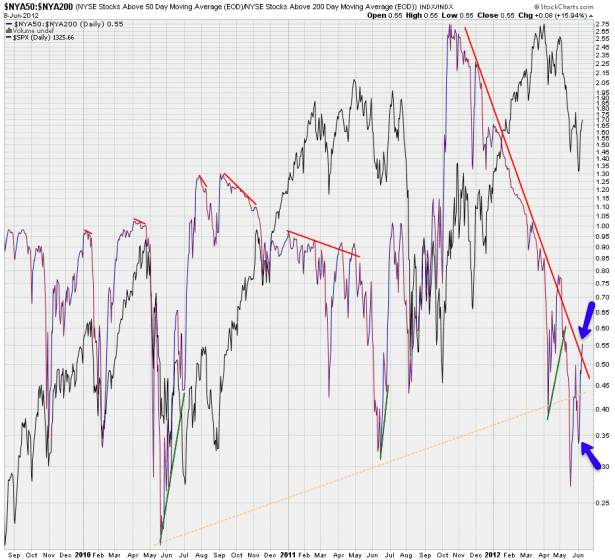
Let’s revisit some of the charts I presented last Sunday. My NYA50/NYA200 ratio showed us a the possibility of a short term bounce and that’s what we got. The big test in my not so humble opinion however will be that diagonal resistance line which needs to be breached with confidence, thus also driving the SPX above 1330.
Here’s the SPXA200R – it measures it percentage terms, thus it’s officially an oscillator. We still have quite a bit downside potential left here as we never got that one big wipeout that would drive it below the 30 mark or lower. Which leaves us a bit in limbo – I would have preferred to see at least a 30 reading – 20 would be better.
My weekly stochastic however is pointing up and claims that this downside correction has run out of mojo. A breach above the 20 mark has led us higher in the past few years. It’s always possible to see one more stab down or even to see us become embedded. This however seems rather rare on this long term chart, at least given recent history.
Then there’s copper still pointing down. Again, I would love to see it join equities and in the context of the previous chart this remains a major fly in my ointment.
Let’s talk about volatility – in particular how market makers seem to view the current situation. Nice divergence at the low (as reported last week) and the fact that the VIX is dropping vs. the longer term VXV suggests that MMs are relaxing a bit on a short term basis.
VIX vs. VXO – I covered that in detail last Sunday in case you don’t know the difference. The unfolding bullish divergence indicates that implied volatility ATM also seems to drop a little.
Finally an update on our TLT vs our 2/20 yield spread. So far that upper resistance line has remained intact and our 0.12 inflection point remains valid. Which suggests bonds may continue higher and the TLT (or 20-year yields) lower.
Bottom Line: On the equities side it’s still technically possible that we continue downward and I don’t see any edge in taking on anything but short term positions while we remain stuck between 1270 and 1330. Let someone else take on risk or get burned by theta while this thing sorts itself out. For now I suggest we do what we do best – which is nothing!
Well, almost nothing. Of course we always have our futures and Forex setups to keep us company while we wait for an opportunity to hitch a ride on the next rocket
Cheers,










